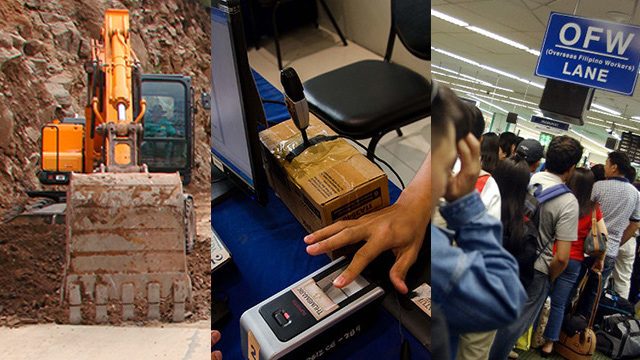SUMMARY
This is AI generated summarization, which may have errors. For context, always refer to the full article.

MANILA, Philippines – For much of the Philippine economy’s sluggish recovery from the first-quarter lull, economists foresee a sunnier future: Growth would pick up steam in the second half of the year, thanks to the expected surge in overseas Filipino workers (OFW) remittances, better infrastructure spending, and the coming elections.
This is despite the expected brunt of El Niño phenomenon and impact of global market volatility in the second half.
“The second half will be better, but, again, agriculture may pull down the surge of gross domestic product (GDP) growth because of weather-related disturbances,” University of Asia and the Pacific (UA&P) economist Cid Terrosa told Rappler.
Bank of the Philippine Islands (BPI) associate economist Nicholas Antonio Mapa mirrored Terrosa’s outlook: “We do see sustained growth in the coming quarters, possibly returning to the 6% handle as we see increased economic activity in the third and fourth quarters to carry the 2015 numbers.”
The economists’ outlook came after the Philippine Statistics Authority (PSA) on Thursday, August 27, announced the economic growth’s slight recovery during the second quarter from the disappointing first quarter performance. (READ: Philippines’ Q2 GDP growth rises to 5.6%)
However, GDP – the broadest measure of goods and services produced across the economy – came in marginally below expectations at 5.6% year-on-year.
The second-quarter GDP growth was also below the general consensus of 5.7% – a “magic number” hoped to buoy up the country’s growth for the rest of the year, following a dismal first quarter performance.
The Philippine economy was able to defy regional slowdown in the second quarter with the help of strong performance of industry and services sectors, as well as robust government spending, National Economic and Development Authority (NEDA) chief Arsenio N. Balisacan said.
“The 5.6% expansion was slightly below our forecast of 5.8%. We had anticipated sustained strength from the services and industrial sectors but we did not see that big a contraction in agriculture,” BPI’s Mapa responded to Rappler via email.
PSA said the second-quarter growth was mainly driven by the services sector, which accelerated to 6.2% from 5.9%. The agriculture sector, however, pulled down the growth with -0.4%.
“My forecast for second quarter was 5.2%-5.4%. I think the annual growth would be at 5.3% as the impact of the global stock market volatility would be felt in the country on the second half,” Asian Institute of Management (AIM) economist Emmanuel Leyco said in an email.
Alvin Ang, an Economics professor at the Ateneo de Manila University, said the second-quarter performace is in line with his group’s forecast of 5.5% with the same drivers.
For Rolando Dy, dean of the School of Management of the University of Asia and the Pacific (UA&P), “5.6% GDP growth in second quarter is not my expectation. I thought industry and services will compensate the agriculture slowdown. Agriculture for second half is tending flat to negative.”

Sunnier outlook for second half
Although most economists said that the Philippines is likely to miss its initial 2015 economic growth target of 7% to 8%, they are optimistic that the second half will be better than the first half of the year.
“Major driver would be private consumption, with only a little help from public spending. Overall, it would be the remittances from overseas Filipino workers (OFWs) that would save the day for the Philippine economy,” AIM’s Leyco said.
“Agriculture is still seen to drag, as well as our trade sector due to the global economic slowdown. However, we continue to be optimistic that the services sector and industry, through construction spending, is seen to lift the overall growth,” Mapa of BPI said.
The first-half GDP growth of 5.3% means the Philippines needs at least 8.7% in the second half to reach the government’s initial full-year target of 7%-8%. (READ: BSP: 7% to 8% PH growth target attainable)
“Even 7% is very hard. That’s why realistically we should probably be looking at 6% to 6.5% full-year GDP growth,” Balisacan said.
“We’ll meet soon with the economic managers to decide on the targets for the rest of the year. It’s very likely that we will scale down the target,” he added.
For economist Terrosa, a 6% full-year GDP growth is realistic. “It will be driven by consumption spending, government spending, and remittances.”
Terrosa added that it’s common for many countries to have GDP growth rates that are below target.
“Setting targets triggers expectations. If targets aren’t reached, it can trigger speculation about the state of the economy. In my opinion, it is more important for GDP to consistently grow even if it misses the target,” he added. – Rappler.com
Add a comment
How does this make you feel?
There are no comments yet. Add your comment to start the conversation.